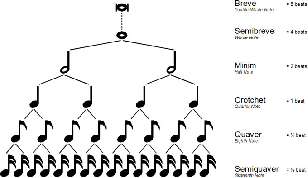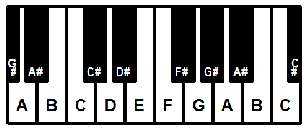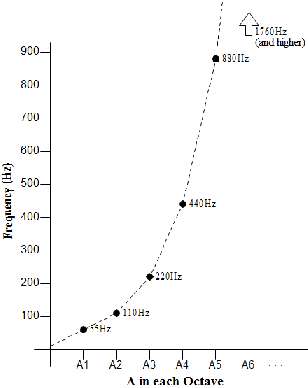Rick's b.log - 2013/05/04
You are 18.225.255.196, pleased to meet you!
Rick's b.log - 2013/05/04 |
|
| It is the 24th of November 2024 You are 18.225.255.196, pleased to meet you! |
|
mailto: blog -at- heyrick -dot- eu
The Breve is twice the length of a Semibreve, however it is shown here merely above with a dashed line because it is infrequent these days. You will not find a breve in a piece at 4/4 time as it would last for eight beats. The correct way to represent this in notation is to have two semibreves (one per bar) which are tied to indicate a continuous note, like this:
While you traditionally write the shorter notes with one or more hooks, those which are in a sequence together may also be written with one or more lines across the top of the note stem. These lines are called beams, and the notes which contain them are called beamed notes. A note will have as many beams as it would hooks, and either way is correct. Thus, in each of the following bars, there are eight quavers:
Typically the note stem goes up if the note is below the middle line of the stave, or down if it is on or above the middle line. My personal preference is to have them all go up - I find it clearer to read.
It is permissible to run beamed notes together, even if the note durations differ. In this case the number of beams following the note will indicate the type of note. Here is a contrived example to demonstrate this:
The last question I will cover here is, if a note is half the length of the next largest note (or double the length of that before), how would you arrive at odd note durations? Say, for instance, a duration of three crotchets?
There are two possibilities. The first is to take a Minim (2 beats) and a Crotchet (1 beat) and tie them. This would result in a single note lasting for three beats.
A typical electronic keyboard will span several octaves from C to C. You might be inclined to think that music is linear, for example that an A would be 100Hz, B would be 200Hz, C would be 300Hz, and so on.
The green key is "Middle C". It is a frequency of 261.626Hz. The blue key to the right of this is known as "A440". This is an A with a pitch of 440Hz. This is referred to as concert pitch as it is the note that orchestras use to tune themselves. Now take a look at the yellow keys. These are all A; and in order from left to right, their frequencies are: 110Hz, 220Hz, [440Hz], 880Hz, 1760Hz. In other words, each A to the right is twice the frequency of the one before. This holds true for all of the keys - the C after Middle C is 523.251Hz.
To put this in visual terms, here is a chart of the frequencies of A from lowest to the highest that would fit without the chart getting silly:
When the same notes are played together (As with As, Cs with Cs), they sound pleasing to the ear due to harmonics. There are no doubt highly complicated mathematical ways of explaining this, however instead of that I'll just provide you with a simple show-and-tell.
Here is the first example. The bass is in harmony with the treble, so it doesn't sound jarring or unpleasant:
Here is the second example. There are twice as many notes, but again they are all in harmony, so it still sounds okay, if a little uninteresting:
Now I would forgive you if you think it sounds a bit rubbish. I'm not trying to wow you with amazing composition skills, just demonstrating basic harmonisation. So here is an example exactly the same as the second, only all the notes have been moved to random positions. This sounds like rubbish. It is unpleasant and displeasing. Why? No harmony. Sometimes this is intentional (try Krzysztof Penderecki's Threnody to the Victims of Hiroshima), but usually harmonic failures just sound bad.
That doesn't mean that you can only have similar notes together. There are fifths, chords, and all sorts of different things that sound good together. Part of the skill of composing is to pick what sounds good and not what clashes. It is hard for us, as individuals, to define good music; I don't mean Bruce Springsteen or Yuki Kajiura, but rather when a piece has a good and pleasing sound. Even if it is a sad piece, it must sound pleasant to the ear or you wouldn't want to listen to it. But what it is, about the melody, the notes chosen, the timing, the arrangement, what is it that makes it sound good? Most of us probably couldn't answer that. But we can sure tell when something sucks.
So your homework for today ☺ is to dig out your favourite tune; whether it be Beetoven's 7th Op 92, or something from the '80s sung by a person who does not want to remember what their hair looks like, Enya, Within-Temptation, etc etc. Dig out your favourite tune and listen to it. Not the words, if it is sung, but the music itself. Listen to how it is constructed. Your first challenge is to try to identify how many instruments there are (real or synth) and what parts they are playing in the overall sound of the music.
Some credits:
More on music - notes
While the durations of notes has been touched on before, the following chart should help to make it clearer. Notes are given with their British/International names in bold, and the American names in smaller text. At the far right is how long the note lasts for, with the crotchet as the basic measure of a beat.

![]()
![]()
![]()
The second possibility is to use a dotted note. Placing a dot after a note adds on a duration of half of its natural duration; thus a dotted Minim would be 2 beats plus an additional beat.
The two different methods are shown here; the squiggly-thing on the right of the examples is a rest (a period of silence) lasting the duration of a crotchet. In each example, the music played is identical - a note for three beats and a rest of one beat.
![]()
More on music - octaves
In Western notation, an octave is one of the basic properties of music. If you look at a piano, you will see a repeating sequence, like this:

Actually, it is completely the opposite. An octave, a span of notes from an A to the next A, is logarithmic. This means that each octave up spans double the frequencies of the previous octave.
To put this in to practice, take a look at this picture of a keyboard:



![]()
![]()

![]()
![]()

![]()
![]()
Please don't think "ah, pfft! can't be bothered". When I stopped just listening to songs and started to pay more attention, I started to hear all sorts of things that hadn't been obvious to me before. There is one song, I forget the title, that had an "epic sax solo" in the middle (very eighties!) but when I listen more, the sax is there all the way along, but it is intertwined with the (electric) guitars so well that you need to pay attention to appreciate its presence. And then I heard the triangle. That silly little thing that they give to no-hopers in music class, it is a triangular piece of metal on a string. You hit it with a thin metal bar. It goes ding. I actually managed to pick this out of the din made by everything else. Sometimes even mass market pop music can be rich and complicated and interesting to listen to.
Rick, 5th May 2013, 01:01 Hello, 20th September 2016, 11:06
| © 2013 Rick Murray |
This web page is licenced for your personal, private, non-commercial use only. No automated processing by advertising systems is permitted. RIPA notice: No consent is given for interception of page transmission. |